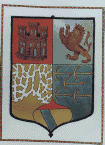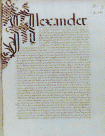
As a reward for his successful voyage of discovery, the Spanish sovereigns granted Columbus the right to bear arms. According to the blazon specified in letters patent dated May 20, 1493, Columbus was to bear in the first and the second quarters the royal charges of Castile and Leon -- the castle and the lion -- but with different tinctures or colors. In the third quarter would be islands in a wavy sea, and in the fourth, the customary arms of his family.
The earlist graphic representation of Columbus's arms is found in his Book of Privileges and shows the significant modifications Columbus ordered by his own authority. In addition to the royal charges that were authorized in the top quarters, Columbus adopted the royal colors as well, added a continent among the islands in the third quarter, and for the fourth quarter borrowed five anchors in fess from the blazon of the Admiral of Castille. Columbus's bold usurpation of the royal arms, as well as his choice of additional symbols, help to define his personality and his sense of the significance of his service to the Spanish monarchs.

The Book of Privileges is a collection of agreements between Columbus and the crowns of Spain prepared in Seville in 1502 before his 4th final voyage. The compilation of documents includes the 1497 confirmation of the rights to titles and profits granted to the Admiral by the 1492 contract of Santa Fe and augmented in 1493 and 1494, as well as routine instructions and authorizations related to his third voyage. We know that four copies of his Book of Privileges existed in 1502, three written on vellum and one on paper.
All three vellum copies have thirty-six documents in common, including the Papal Bull inter caetera of May 4, 1493, defining the line of demarcation of future Spanish and Portuguese explorations, and specifically acknowledging Columbus's contributions. The bull is the first document on vellum in the Library's copy and the thirty-sixth document in the Genoa and the Paris codices. The Library copy does not have the elaborate rubricated title page, the vividly colored Columbus coat of arms, or the authenticating notarial signatures contained in the other copies. The Library's copy, however, does have a unique transcription of the Papal Bull Dudum siquidem of September 26, 1493, extending the Spanish donation. The bull is folded and addressed to the Spanish sovereigns.

 Continue the Voyage with
Continue the Voyage with